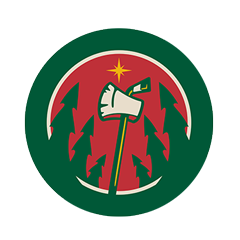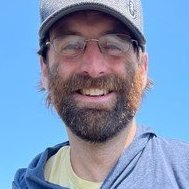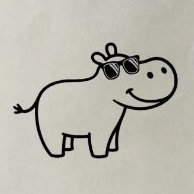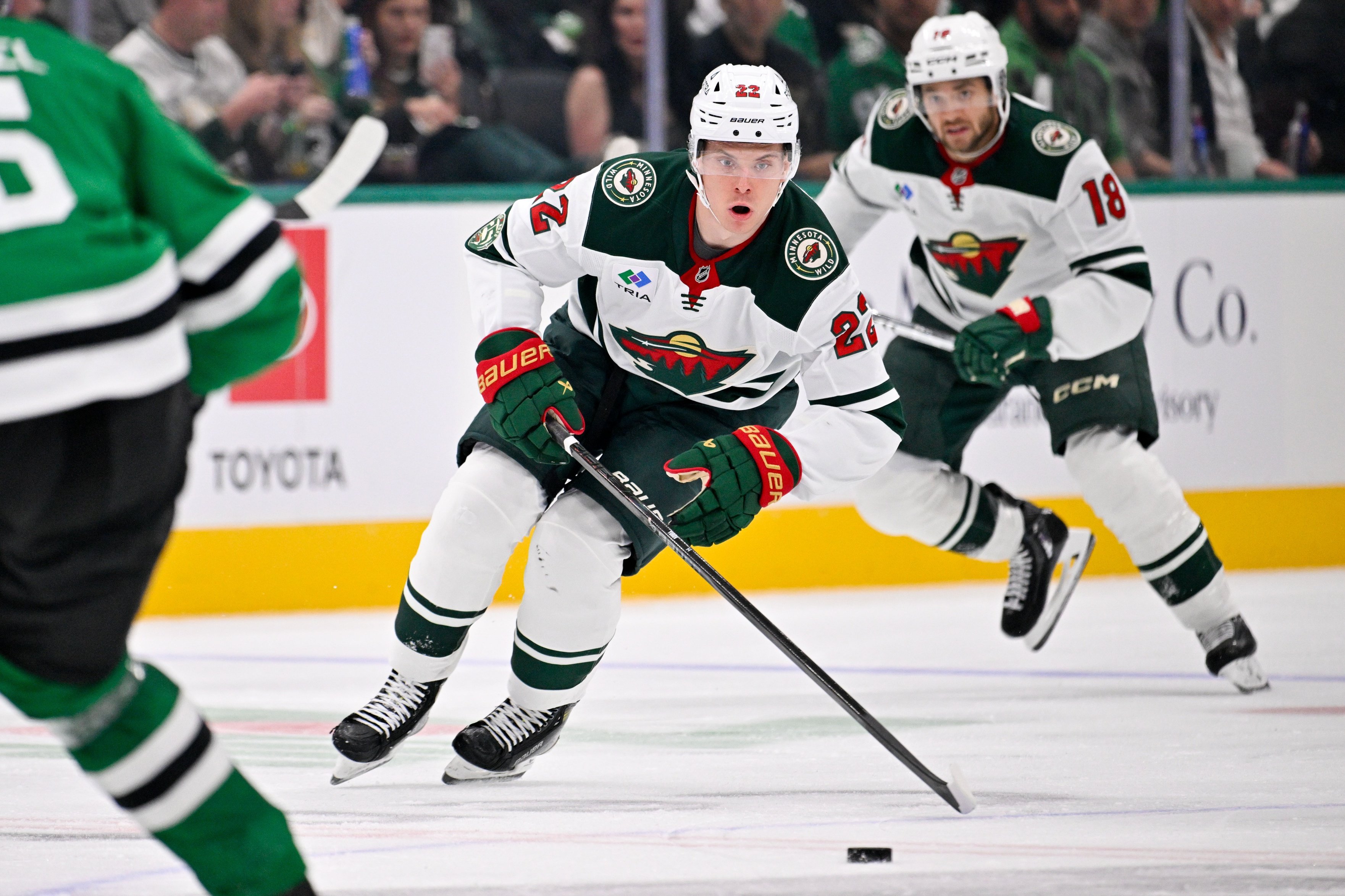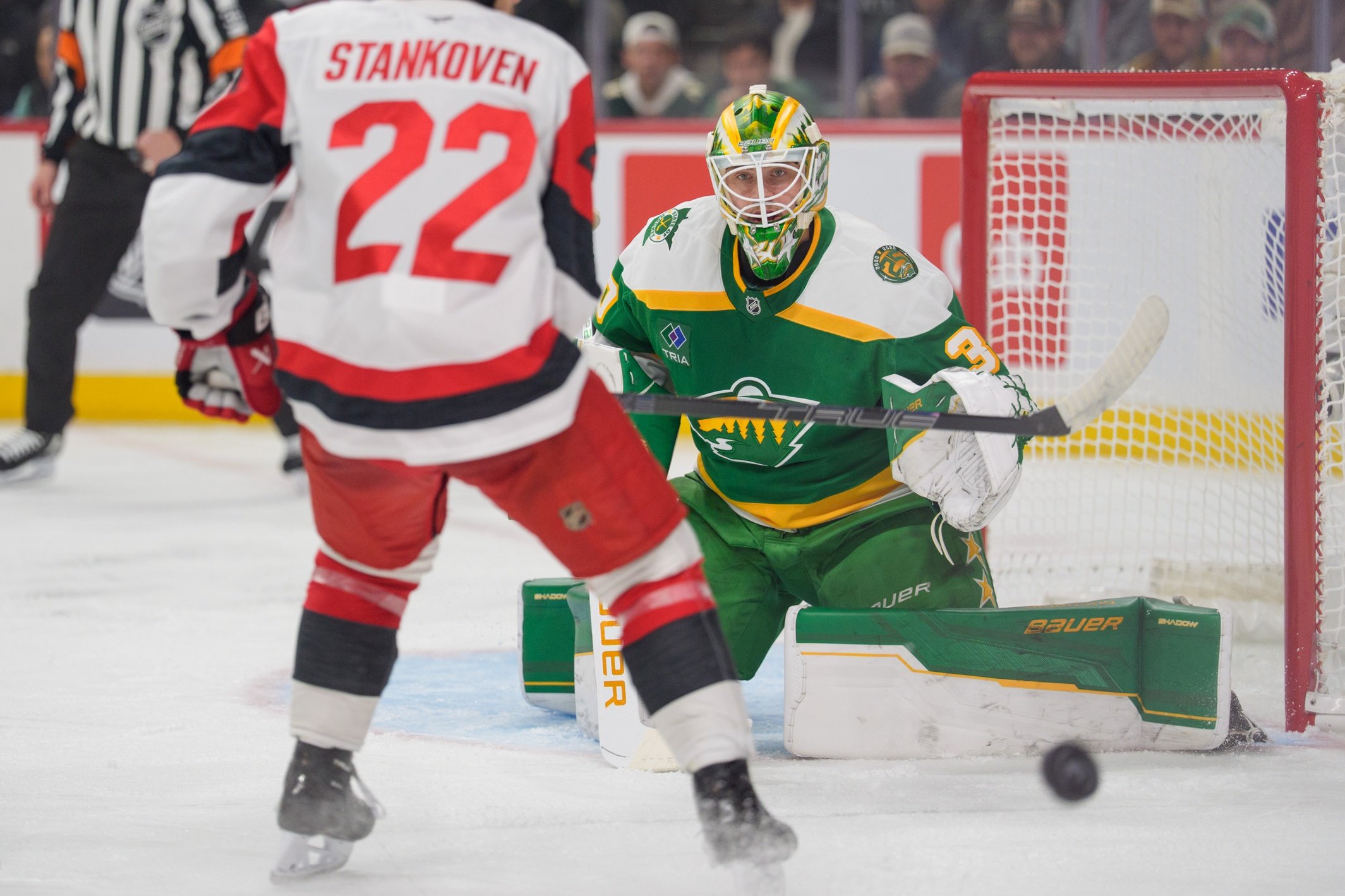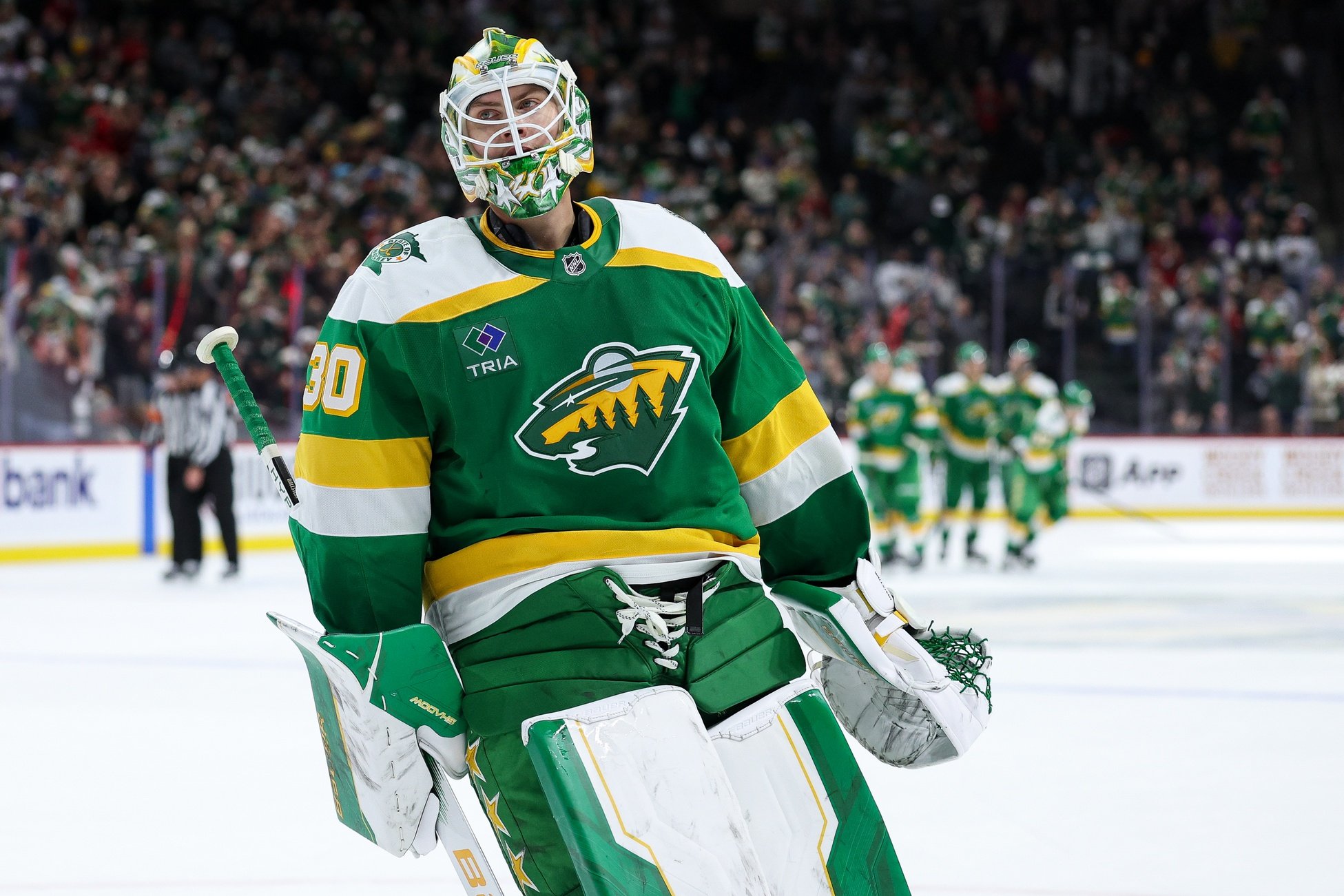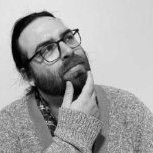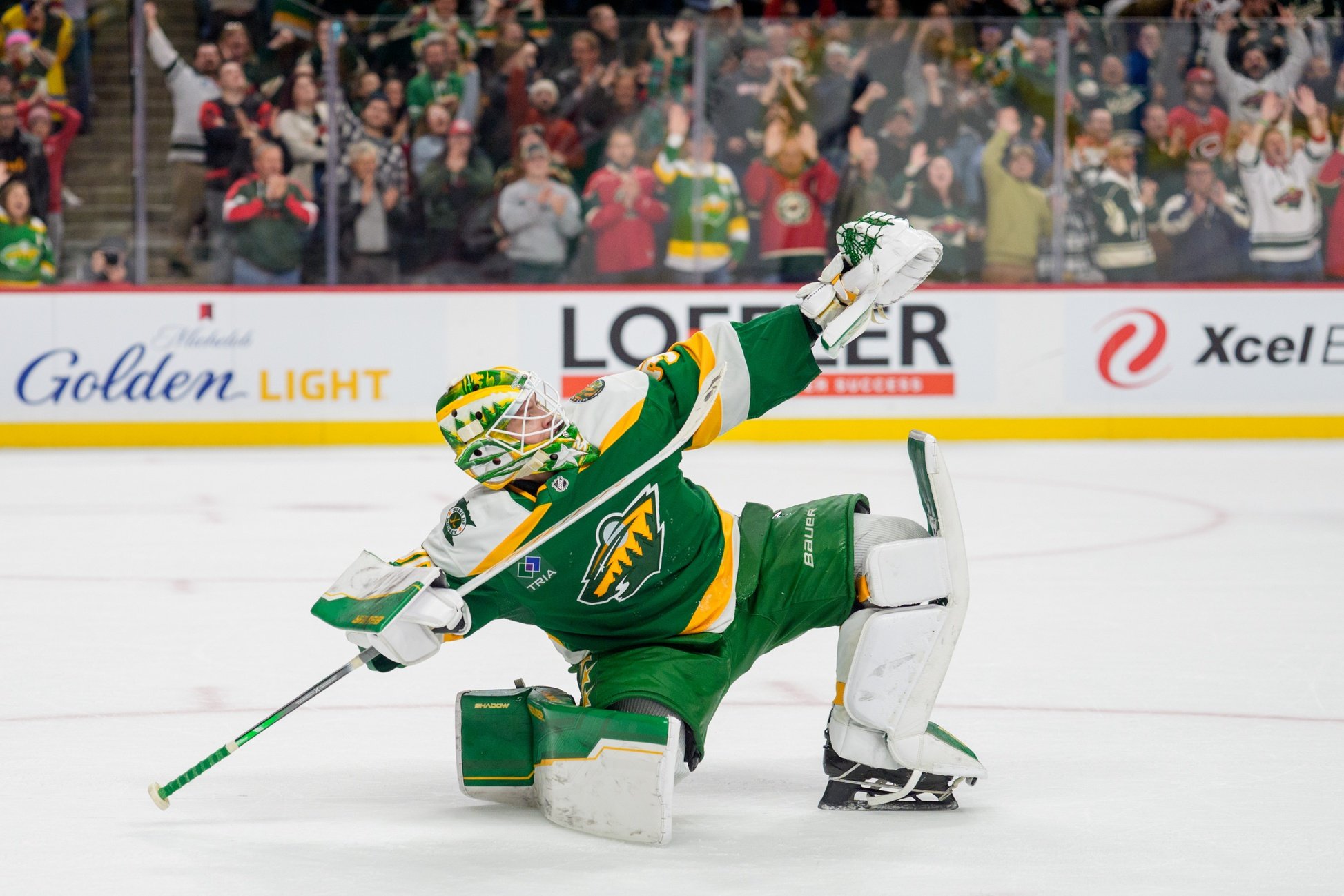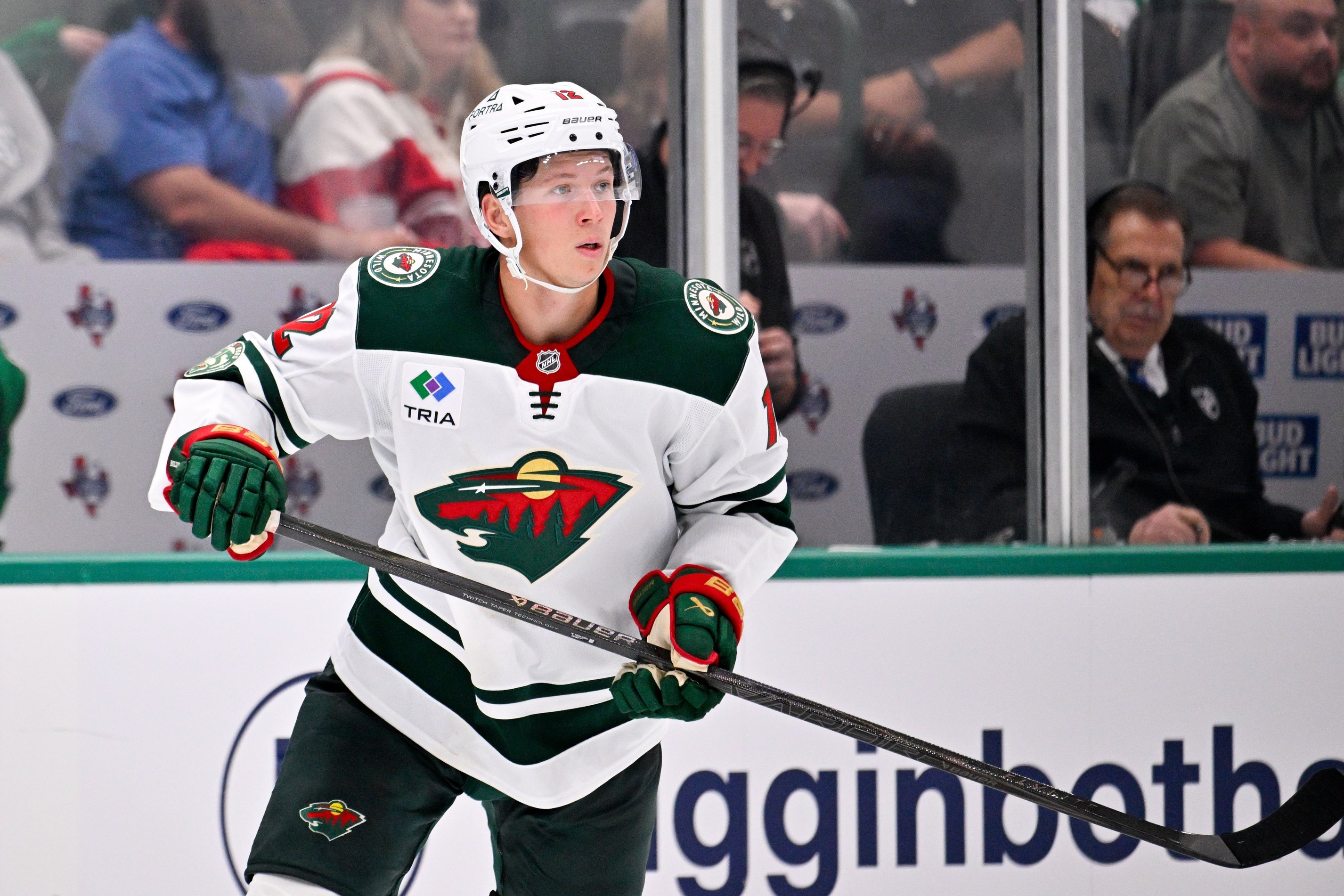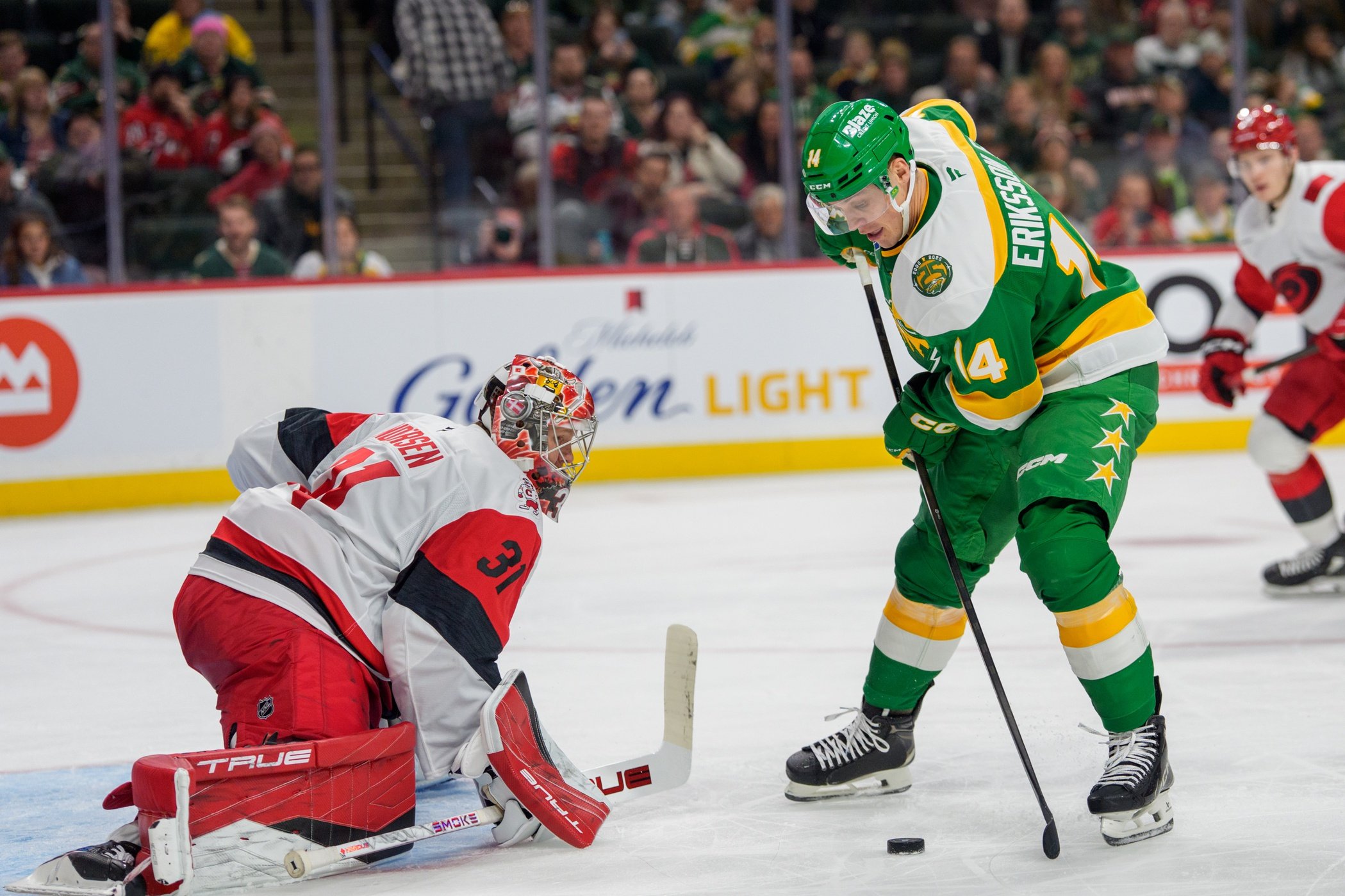Leaderboard
Popular Content
Showing content with the highest reputation since 11/18/2025 in Articles
-
In the age of analytics, player tracking, and data overload, sometimes the good, old-fashioned eye test gets overlooked as fans and media scrutinize players. There’s a reason for that, of course. History has proven that the eye test alone isn’t sufficient for overcoming biased perceptions or imperfect observations that can cloud analyses and lead to poor decision-making. However, there are times when you see a player, and you just know. That’s been the case with rookie Danila Yurov during his rookie season in Minnesota. Beginning with the Tom Kurvers prospect showcase, then in training camp and preseason, and on through the first 15 games of his NHL career, the 21-year-old from Chelyabinsk, Russia, has looked the part of an NHL player. His game at the Kurvers showcase was representative of a player still finding his stride. Still, even then, he clearly was a step above most of the prospects there. It was the first glimpse of the skating, puck pursuit, and remarkably mature two-way game that reflected a player who arrived in North America as a pro-ready prospect. Yurov carried that momentum into training camp, where he steadily progressed as the preseason went on, getting better with each game as he adapted to the smaller ice and faster pace. He displayed skating and hockey sense and diligent two-way play throughout camp. It was clear he was ready to be a valuable contributor and produce quality shifts regularly. Yurov’s game hasn’t been flashy, but it’s been steady. He’s in the right places. He stays above the puck, takes smart angles to win puck races, isn’t afraid to go to the net, and covers a lot of ice with his efficient skating. He just keeps getting better, little by little, and it’s been noticeable. John Hynes and the Wild coaching staff have clearly seen it too, deploying Yurov primarily at center after he began the season at wing. In the team’s most recent game, a 3-2 overtime win over the first-place Vegas Golden Knights team, Yurov played a season high 13:09, including nearly four minutes on the top line with Kirill Kaprizov and Mats Zuccarello after Ryan Hartman left with an injury. After the recent news that Hartman is week-to-week with a lower-body injury, and with Marco Rossi still on the shelf, The Athletic’s Michael Russo has reported that Yurov is going to get another shot with the Wild’s dynamic duo against the Carolina Hurricanes on Wednesday. Playing on the top line against the Hurricanes will be Yurov’s stiffest test yet. They have looked like a buzzsaw this season, overwhelming opponents with their depth, aggressive defending, and relentless forechecking. The Wild experienced this first-hand less than two weeks ago, when Carolina thoroughly outplayed them for long stretches during a 4-3 defeat. Yurov was a healthy scratch for the third consecutive game that night in Carolina. It’s not a coincidence that he's been in the lineup every night since. His skating and intelligence would have been an asset. The Wild first activated him the next night against the New York Islanders and made an immediate impact with a first-period goal. Yurov makes small but noticeable contributions almost every shift, and he’s starting to pass more than just the eye test. According to Natural Stat Trick, he has produced an expected goal percentage of 55% or higher in five of his past seven games, and the Wild have outscored their opponents 2-0 during his minutes over that time. Minnesota has also broken even with high-danger scoring chances during his minutes over that stretch. He produces these numbers with intelligent positioning, a surprisingly strong stick that can win puck battles or maintain possession under pressure, and excellent skating. On Yakov Trenin’s first goal of the season against Vegas on Sunday, Yurov made two key plays that led to the goal. The first was out-leveraging Ivan Barbeshev for a loose puck after the Wild entered the offensive zone, and the second was another won stick battle in which he beat Ben Hutton to a loose puck down low and poked it free to Trenin. He did that after he made the correct read to get to the corner and capitalize on a loose puck created by Marcus Foligno. Yurov earned his first career assist on this play, and the way he did it is indicative of how he’s been able to turn in a quietly impressive rookie campaign. Smart reads, timely positioning, and a good stick go a long way in the NHL, where victories often hinge on repeatedly winning the small moments. He’s still a young player who will have some rough nights here and there, and there’s a lot of hockey left to be played this season. Still, there’s no question that Yurov is becoming a valuable contributor to Minnesota’s lineup. Wild fans have long wondered exactly what type of player he’d be once he finally arrived, and they haven’t been disappointed. Because when it comes to this rookie, seeing is believing.7 points
-
Every hockey team strives for depth in its lineup. The Minnesota Wild have struggled with lineup depth in the past and are missing most of the centers they started the season with. Somehow, the Wild are still one of the hottest teams in the league right now, and part of that might be the fact that so many of the players are slightly different versions of each other. Rossi Is A More Polite Version Of Eriksson Ek Besides the obvious similarities (both play center and are European), Marco Rossi has been trying even harder to embody Joel Eriksson Ek's personality. He’s been gaining muscle during every off-season, and it’s shown in the way he plays the game. Sure, Rossi might be undersized, but he’s been more willing to engage in the board battles. He’s got a bit of the Eriksson Ek grit to his game. However, Rossi is generally more polite, which is probably why he doesn’t get punched in the face as often as Ek does. Middleton Is A Suburban Version Of Bogosian Two big defensemen who are both known for their facial hair, Jake Middleton and Zach Bogosian, are on the two ends of the Wild’s defensive core. Middleton is the surprise top-four defenseman who thrives next to our diminutive captain. Bogosian is one of the last Atlanta Thrashers players in the league, playing on the third pairing for the Wild next to some of the young blue-liners. He's an outdoorsman who loves to hunt and fish, and his scraggly hair and beard fit that persona. Middleton, on the other hand, seems more like a suburban dad who might not be crazy about outdoor life, but enjoys mowing the lawn of his suburban McMansion. Boldy Is the Cat Version Of Faber These young players are complete opposites in so many ways, but Matt Boldy and Brock Faber are also besties who have earned the couple nickname Foldy. Faber is a golden retriever in every sense of the word. He’s almost always got a smile on his face, and he is full of youthful energy. Boldy can be like that sometimes, but most of the time, he is more of a cat. He typically looks like he is judging you, and he’s more likely to give the cold shoulder than Faber is. Zuccarello Is A Smaller, Sneakier Version Of Hartman If Ryan Hartman is a rat, then what does that make Mats Zuccarello? They have different play styles, but at the end of the day, they both enjoy annoying players on the other team. Hartman is more of a mouthy rat, while Zuccarello has those crazy eyes that make him hard to read. While Hartman will call you names to your face, Zuccarello seems more like he would gossip about you behind your back, which is even harder to come to terms with. Gustavsson Is the Dad Version Of Wallstedt The Wild's Swedish goalie tandem has been a dream team lately. Could that be because Wallstedt is a younger, non-father version of Gustavsson? Maybe this one is a bit too obvious, but it makes sense, doesn’t it?3 points
-
Goalies are voodoo. Not a single person who walks God’s green earth knows exactly what makes a goalie good or if a young goalie prospect will reach his full potential. Some guys show promise early, some guys don’t figure it out until they are 30, and others never reach it at all. Some guys just need a change of scenery, regardless of age, ask Darcey Kuemper and Devan Dubnyk. After the season Jesper Wallstedt had in the American Hockey League last season, it was not looking great for the former first-round pick. Wallstedt had just spent his third full year in Iowa, where it was his worst season yet. He had a .879 SV% and a 3.59 GAA in front of a brutal lineup. Wallstedt also suffered three separate injuries over the course of the season and only suited up in 27 contests. However, the Minnesota Wild did him no favors by misleading him about his role on the team. Wallstedt expected to play a decent amount of NHL games in a three-goalie rotation with Marc-Andre Fleury and Filip Gustavsson. Still, at the start of the season, Minnesota optioned Wallstedt to Iowa, where he struggled. Losing a rotational NHL opportunity affected his confidence. He was touted as the best goalie prospect in the world, and his AHL numbers suggested a player who had lost his mojo. But confidence is a fickle thing, and it looks like the Wall of St. Paul found it again this year. Wallstedt leads the NHL with a 96.7% save percentage (SV%) since the start of the month. He posted back-to-back shutouts against the Anaheim Ducks and the Calgary Flames, and Wallstedt holds the longest shutout streak in the NHL. “If there were no goals scored in hockey, no one would play it,” Wallstedt recalled. “That kind of made me think a little bit, like, ‘Okay, there’s supposed to be goals in hockey.’ But then it’s my job to not make them happen.” In every game Wallstedt has suited up for the Wild, they’ve earned a point, leading to a 5-0-2 record in his seven starts. He’s making it happen! Wallstedt’s play has been a huge reason this team has rebounded to a Wild Card spot and is tied for third in the Central Division. “That’s my game plan, kind of. I want to be there. I want to make it look easy,” Wallstedt said. “I want to more so make it look like I’m getting hit than making saves. When the puck comes to me, that’s usually a good sign instead of me chasing the puck. “That’s something I did last year. Now I’m trying to make the puck come to me instead. Yeah, it’s been working good. Rebound control has always been my strength. I’m happy with the confidence I have. I can keep a lot of pucks and get whistles on them.” So that begs the question: If Wallstedt keeps this up, could he be in the conversation for the Calder Trophy, the NHL’s rookie of the year award? Well, even if he does, he probably won’t win it. Last year, Macklin Celebrini won the Calder, but Calgary Flames rookie goalie Dustin Wolf finished second with a stat line of 53 games, 2.64 GAA, and a .918 SV% as Calgary’s primary goaltender. Steve Mason was the last goalie to win a Calder Trophy. He played 61 games for the Columbus Blue Jackets in 2008-09, posting a 2.29 GAA and a .916 SV%. Those are unreal numbers for such a young goalie in a starter role. Even if Wallstedt maintains his numbers, he probably won’t get the number of games required to be in this conversation. The Wild still have an outstanding goalie in Gustavsson, who will continue to get his fair share of starts. The other variable is his competition for the Calder. Matthew Schaefer, who has been elite in his first NHL games, is the leading rookie of the year candidate. Given that he’ll probably play for Team Canada in the Olympics at age 18, he’ll likely win the Calder this year. Wallstedt probably won’t win the Calder, but he looks like he can be the goalie on a Stanley Cup-winning team. All stats and data via HockeyDB, Evolving Hockey, and Moneypuck.com unless otherwise noted.3 points
-
There’s no one-size-fits-all approach when it comes to winning in the NHL. While there are lots of ways to win a hockey game, the best teams in the league generally have a well-developed identity. The Florida Panthers are relentless forecheckers with total buy-in from every player; the Colorado Avalanche blitz with pace and puck possession. The Minnesota Wild kind of lacked an identity until they started winning. With the duo of Filip Gustavsson and Jesper Wallstedt, Minnesota is becoming a team built on a high-end goaltending battery. Wallstedt is the league’s hottest goaltender, with three shutouts in his last four starts. Gustavsson has responded by also playing his best hockey of the season, with a .921 save percentage since the start of November. The hot streak by both goaltenders has been the driving force behind the Wild going 9-1-1 this month and turning around a difficult start to the season. Two goaltenders playing so well could lead to a few outcomes. There may be some calls to trade one of the goalies while they’re at peak value. There could be a goaltending controversy over who becomes the clear starter. Or you could also have two good goalies. With Wallstedt and Gustavsson on team-friendly contracts, the best option is for the Wild to have two high-end starters. Thankfully, John Hynes seems bullish on going with a rotation. "Right now, the way both guys are playing is for sure. That’s what we’ve done for the last few games. I would anticipate that moving forward," Hynes said. "I think there might be opportunities and stretches in the season where you possibly could ride one guy a little bit more than the other. But the way our two guys are playing and competing, it looks like a good recipe right now." The duo also agrees that their high-quality play is pushing them to be better. Jesper Wallstedt reflected on the dynamic recently, saying that it’s been a positive development for both of their games. “It makes both goalies compete, and both goalies get better from it, I think," Wallstedt said. "I think if both want to play as much as possible and kind of make the other one play a little less, I think that’s a healthy competition, and obviously, I know my role a little more coming into this year.” That healthy competition has obviously worked wonders for the duo. We’re looking at stats from a small sample size, but they don’t even scratch the surface of just how dominant the duo has been. Since November 1, the Wild lead the league in 5-on-5 save percentage with their goalies saving 96.53% of shots on goal. They’re second in the league in that stretch in high danger save percentage with an 88.89% mark. That accomplishment is especially impressive considering the Wild are giving up 26.56 scoring chances against per game, which is 12th-most in the league. In that same time frame, Wallstedt leads the NHL in GSAA/60 (1.52) while Gustavsson places 18th (.38) out of the 73 goalies who have made more than one start. They’re also both top 20 high-danger saves per 60 with Gustavsson in 14th place (6.87) and Jesper Wallstedt in 18th (6.65). Of course, Minnesota’s goaltending in the last month is challenging to count on long-term. Wallstedt isn’t going to continue shutting out three of every four opponents he faces. There’s a difference between a goaltending hot streak and being difficult to score against being a franchise’s defining identity. That identity comes when a team pairs strong goaltending with a stifling defensive structure that supports sustained success in limiting scoring. Fortunately, that’s perfect for the Wild. Minnesota has always been at its best when playing defensively sound hockey. Since the 2022-23 season, the Wild have surrendered the 3rd-least high-danger chances against (2645) in the league while ranking 11th-lowest in high-danger chances for (2851). Minnesota also ranks 3rd in expected goals against per game (2.79) and is a bottom-ten team in expected goals for per game (2.95). It may not be the most exciting brand of hockey, but the Wild are clearly constructed to limit chances and play the dreaded “low-event” style. Still, while it may not be glamorous, it’s actually the perfect fit for a team that is leaning into an identity as hard to score against, with two elite goaltenders. It’s a formula that has produced positive results in the past, especially for teams that need to get as much as they can out of a roster with limited scoring ability. The best example of a template the Wild could follow is emulating the success of the Barry Trotz-era New York Islanders. From 2018-19 through 2020-21, the Islanders were one of the best teams in the NHL. They reached the conference finals twice, including a Game 7 against the eventual champion Tampa Bay Lightning in 2020-21. New York’s calling card was low-event hockey with potent goaltending duos. During that time, the Islanders led the league in save percentage from their goaltenders and, like the Wild, ranked in the top ten in expected goals against per game (2.61) and in the bottom ten in expected goals for per game (2.65). The Islanders achieved that defensive excellence with sterling goaltending duos, including Robin Lehner and Thomas Greiss, Semyon Varlamov and Thomas Greiss, and Semyon Varlamov and Ilya Sorokin. During that time, every goalie had a positive goals saved above average rating, and none started more than 45 games in a season at any point in the stretch. While they never reached the Stanley Cup finals, the Islanders clearly delivered strong results and were a tough team to play against every time they took the ice. In the past, the Wild have played that low-event style, but haven’t gotten good enough goaltending to follow through on it fully. That’s the issue with playing slow hockey. When you’re giving up goals and can’t keep up with scoring, it’s a bad recipe for winning. But that equation finally looks different now. With Wallstedt and Gustavsson giving Minnesota the goaltending this system has always required, the Wild can finally commit to the identity of being a goalie team.2 points
-
Jesper Wallstedt is the story of the Minnesota Wild and their November turnaround. No shade to Filip Gustavsson (4-1-1 record, .921 save percentage this month), but "The Great Wall of St. Paul" is on an entirely different level right now. After Sunday's 32-save shutout in Winnipeg -- the second in franchise history! -- Wallstedt is now 5-0-0 in November, and 6-0-2 with a league-leading .935 save percentage for the season. We'd usually say "it's a small sample size" here, but throw it out the window. It's end zone dance time. Wallstedt deserves this one, especially since he was essentially left for dead as a top prospect based on... a small sample size. We know Wallstedt's story from last season. The Wild told him he'd get NHL time, only for salary-cap issues to immediately thwart that plan. However, what we perhaps overlooked was how much his lost season was affected by a handful of games at the beginning. Wallstedt finished his season with the Iowa Wild with an abysmal .879 save percentage in 27 games. However, the worst games almost exclusively happened in his first 10 starts. During that span (through November 24), he had given up five or more goals in five starts and had an .844 save percentage. It's like hitting .090 for six weeks to start a baseball season. There's just no coming back from that. The last 17 games weren't good, by any stretch of the imagination, but they weren't awful, either. Or at least, not that awful. After a two-week reset, Wallstedt went the rest of the way with an .890 save percentage. Mind you, that was all behind an Iowa Wild defense that, under Brett McLean, wasn't doing their goalies many favors. Context matters, and there was a lot that went into Wallstedt's awful year. He was overpromised and clearly struggling with that as he underdelivered, with little talent in the AHL to support him. But all the scouting community saw was the underdelivering. That's going to sound like a dunk on some really smart people, folks who talk to more scouts and watch more tape than anyone at this site does. It's not. Prospect evaluation is a tough gig: tracking the talent pools of 32 teams spread across a dozen or more leagues scattered around the world. Even the best are going to be wrong, and even the best can fall victim to recency bias. But looking at Wallstedt's overall trajectory, this is what he was supposed to be all along. Maybe not "Vezina-caliber numbers," but there was a reason many considered him the best goalie prospect in the world until a year ago. At every step of his development, Wallstedt handled himself well despite much older competition. That included two seasons in the AHL, sporting a .909 save percentage over 83 games behind the Iowa Wild's defense. A year where a goalie falls off the table entirely is always concerning, but the overall body of work gave a lot more to suggest that he'd be able to carve out a good NHL career. While we've just seen Wallstedt excel for eight games, it's been a scintillating performance at arguably the worst time to be a goalie in modern NHL history. Entering Sunday, the league-wide save percentage for the 2025-26 season was .897 -- down from .900 last year. You have to go back over 30 years to the 1993-94 season to find a worse save percentage (.895). Meanwhile, Wallstedt is looking like Dominik Hasek (.930 in 1993-94). His three shutouts also make up for 10.7% of the league total through November 24. Why was everyone out on this guy again? Maybe it's just the Wild fandom that makes seasons when a goalie loses it all seem normal. Darcy Kuemper couldn't buy a save as a young goalie in 2014-15 or 2016-17, and all he's done since leaving Minnesota is win almost 200 games and a Stanley Cup. Devan Dubnyk played his way to the AHL in 2013-14 at age 27, but managed to be a Vezina finalist the next year. It's also fair to caution about getting too high on eight games, and that will be the challenge for Wallstedt. Even when he succeeded for his first two seasons in the AHL, he'd go on extended hot streaks that were balanced out with elongated cold streaks. Wallstedt is going to have bad games and bad streaks, but how quickly he'll pull out of those tailspins will determine whether he's an eventual 60-game workhorse or merely a great tandem option. But that's in the future. For now, Wallstedt has rebuilt himself into a formidable netminder, taking starts from Gustavsson. Since Gustavsson took five straight starts from October 28 to November 6, Wallstedt has scratched out five starts to Gustavsson's three. It's a big vote of confidence, especially since Wallstedt has taken starts against the Eastern Conference Finalist Carolina Hurricanes and the Wild's nemesis in the Winnipeg Jets. It won't be surprising to see Gustavsson slot in against the Chicago Blackhawks on Wednesday, with Wallstedt getting the nod to face Nathan MacKinnon, Cale Makar, and the Colorado Avalanche. As quickly as he vanished from the map, Wallstedt is back on it.2 points
-
Minnesota Wild fans have known that Matt Boldy arrived in the NHL a long time ago. The only question is how high his ceiling could be. For most of the 24-year-old’s career, the conversation has been centered around his offense. Bill Guerin mentioned before last season that he believed that Boldy could someday become “a 50/50 guy,” recording 50 goals and 50 assists in a season. His playmaking ability is also apparent when he’s on the ice, using space correctly and finding an open teammate. But for all the talk about Boldy’s offense, his defense is beginning to take center stage, and it could be the final step needed to go from an All-Star caliber player to a franchise player. Boldy’s defensive play has been a hot topic as he’s made a couple of crucial plays during the Wild’s recent hot streak. Minnesota has won seven of its past nine games and collected points in eight of its last nine. The key has been a commitment on defense, where the Wild have allowed two goals or fewer in seven of those games. To that extent, Boldy has been leading the charge. In a Nov. 16 overtime win against the Vegas Golden Knights, Mitch Marner went on a breakaway in overtime that seemed to spell doom for the Wild. When Marner passed the puck behind him to Shea Theodore, it was Boldy who sprinted down the ice after a turnover and lifted his stick to extend the game and help Kirill Kaprizov score the eventual game-winner. On Wednesday night, Boldy’s defense played another key role in the Wild’s win over the Carolina Hurricanes. Already up 1-0 on Brock Faber’s goal early in the game, Boldy made an excellent read on an entry attempt by the Hurricanes, leading to a breakaway and giving Minnesota a 2-0 lead. The Hurricanes came back to force overtime, and Boldy’s shootout winner drew the headlines along with a highlight-reel save by Jesper Wallstedt. But if it weren’t for Boldy’s play earlier in the game, the Wild may have never been in that position, which shows how big a development his defense has become. Like many aspects of Boldy’s game, he laid the foundation a long time ago, and it’s beginning to reach elite levels. According to Evolving-Hockey, Boldy is currently a top-20 defensive forward in their goals above replacement metric at 1.9. He also ranks in the 91st percentile defensively, which puts him among the league’s best defenders at the forward position. As a result, the Wild have given Boldy priority assignments throughout the year as part of the Wild’s top defensive line alongside Joel Eriksson Ek and Marcus Johansson. But it also serves as a steady foundation to an offensive game that is still growing. Guerin mentioned during a TV interview earlier in the year that a strong defensive game is critical to long-term success in the NHL. When the offense runs dry, players can lean on their defensive game and remain viable contributors. Boldy did some of this one year ago when he endured three stretches without a goal in nine games or more. The worst drought came late in the year, with a 15-game stretch with just two goals coming out of the 4 Nations Tournament. The slide, where the Wild posted a 6-8-1 record, turned a fast start into a crawl toward the playoffs, but Boldy worked on the little things to keep the team afloat. “It’s hard to score, no question about it, when things aren’t going your way, things aren’t going in,” Boldy said at the end of that slump last March. “As I’ve played more and more, you realize that you’re going to go through these ups and downs. You don’t want to. But you can’t be nonexistent when it’s not going in.” So far this season, both aspects have come together. Boldy is tied for the team lead with Kirill Kaprizov with 11 goals and second on the Wild with 22 points entering Friday’s game against the Pittsburgh Penguins. While his offensive output has been key, his defense has been just as crucial on a team that needs to limit offensive chances until it can find dynamic upgrades deeper in its lineup. If the Wild want to keep their recent hot streak from being their annual Thanksgiving resurgence, Boldy will still have to contribute on the offensive end. However, his defense is providing the team with a steady foundation and could be the cornerstone that turns him into the franchise player the Wild fans believe he can be.2 points
-
For most of the Minnesota Wild's existence, they've been what broadcaster Jeff Marek would often call "a donut." Why? "No center." It's not the sweetest way to put it, perhaps, but it's an accurate assessment of why the Wild tend to get burned to a krisp or kreme'd in the playoffs. Once the first round hits, they've had to match either Mikko Koivu or Joel Eriksson Ek down the middle against the likes of Jonathan Toews, Nathan MacKinnon, Mark Scheifele, Roope Hintz, and Ryan O'Reilly. Nevertheless, the Wild hoped to enter the season with their deepest stable of centers in team history. Marco Rossi had a strong 2024-25 campaign, Eriksson Ek was as reliable as it got, Ryan Hartman shone bright in the playoffs last year, and Danila Yurov's arrival injected some much-needed youth and upside for the lineup. There was a lot of optimism, but the first quarter of the season had the Wild looking... like a donut. Of the Wild's four centers, only Rossi started strong out of the gate, scoring 12 points in his first 12 games. Eriksson Ek scored just his third goal on Sunday and has 13 points through his first 21 contests. Hartman notched two goals on Opening Night... and has just two goals and five points through 19 games. Yurov has had to fight to stay in the lineup, having as many healthy scratches as points, with five apiece. But it could always get worse, as we learned this week. Rossi, who had been battling a lower-body injury since Game 2, finally went on injured reserve and is week-to-week. The same terrible fate of being week-to-week has also befallen Hartman. Eriksson Ek remains a rock in the top-six, but Yurov had to go from the fourth line to taking center stage between Kirill Kaprizov and Mats Zuccarello on Wednesday night. Yakov Trenin, who took just 48 faceoffs all of last season for Minnesota, drew third-line center duties. Throw in Ben Jones, and you're talking about a quartet of centers who combined for six goals and 20 points in a combined 63 games entering Wednesday's tilt with the Carolina Hurricanes. But somehow, someway, the Wild were able to make that work in a 4-3 shootout win against the Canes. It was very rarely pretty. After building a 2-0 lead, the Hurricanes did what they do best: build up insane shot quantity. They peppered Jesper Wallstedt with 45 shots on the night, which was just enough to chip away at a 3-1 lead in the final minutes. But when you're down two centers, banking two points is good, no matter how it happens. The only question is, how long can this continue? Let's assume Rossi and Hartman are back on December 4, two weeks from Thursday. During that time, the Wild are going to have to get through a schedule that's much tougher than what they've faced lately. Grinding out extra-time wins against Carolina and the Vegas Golden Knights are noteworthy, of course. But the 7-1-1 run that brought Minnesota back into the playoff bubble came against a generally weak stretch of teams. The Vancouver Canucks, Nashville Predators, San Jose Sharks, and Calgary Flames are the dregs of the Western Conference. Even the first-place Anaheim Ducks are a young team for whom the Wild have their number for years, winning 19 of their last 20 games against them. Vegas and Carolina only mark the beginning of the schedule ramping up. They'll have to go on the road to face the Winnipeg Jets and Edmonton Oilers. The Colorado Avalanche will come calling. Even if you think the first-place Pittsburgh Penguins and surprisingly not-terrible Chicago Blackhawks are smoke-and-mirrors, the former still managed to give the Wild a 4-1 beatdown at home on October 30. And notably, the Wild will have Eriksson Ek, Yurov, Trenin, and Jones facing off against Sidney Crosby, Evgeni Malkin, Schiefele, Connor Bedard, MacKinnon, Tage Thompson, Connor McDavid, and Leon Draisaitl over the next two weeks. Uh-oh. So, how do they survive? It's not sustainable, but riding a red-hot goaltending duo of Wallstedt and Filip Gustavsson lifted them past Jack Eichel's Golden Knights and Sebastian Aho's Hurricanes. Continuing to be stout on the back end will also be critical. It's important to note that even as Carolina dominated the shot share, Minnesota did a reasonable job keeping the Hurricanes to the outside. They're also going to need to watch Yurov grow up fast, and luckily, we saw him thrive on Wednesday. Finally getting a shot at a top-six role after being buried on the fourth line for most of the season, Yurov looked at home between Kaprizov and Zuccarello. He had just one shot on goal but got another huge chance that missed the net, and he registered two assists. The first one was especially encouraging, as he sent a backhanded pass to Zuccarello that surely made Kaprizov proud. But make no mistake, Rossi and Hartman still leave two massive holes on a team that was arguably a donut to begin with. The Wild have already had to go on a run to save their season, but the degree of difficulty is getting turned up on more than one front. Now the training wheels are off, the competition is harder, and the injury road is rockier. As good as Matt Boldy and Kaprizov are on the wings, Jonas Brodin and Brock Faber are on the blueline, and Wallstedt and Gustavsson are in net, the center has to hold if the Wild are going to keep making a playoff push.2 points
-
The Minnesota Wild seem to have recovered from their early-season struggles, at least for now, but that isn’t stopping people from discussing how Minnesota could improve its roster. Trade talks are running rampant, with Joe Smith and Michael Russo confirming that Bill Guerin is looking to improve the roster. “If he can trade for a top-six forward, he will try,” they wrote. “In fact, it’s abundantly clear Guerin has been working the phones pretty furiously lately.” Smith and Russo discussed players the Wild might dangle in trade talks in their most recent Athletic Q&A, with one name in particular standing out: Danila Yurov. Yurov hasn’t quite lived up to the expectations that made him Hockey Wilderness’ No. 2-ranked prospect leading into the season. Still, there should be significant concern about moving the 21-year-old forward so early in his career. Yurov Carries Significant Value The Russian forward has only played 15 games for the Wild. That’s not nearly enough time to make determinations as to whether he can reach the potential he showed when breaking the KHL scoring record for a player under 21 years old. Yurov possesses NHL size and speed, though neither of these is an elite tool for him. Instead, he’s known for his two-way play. "Yurov [excels] as a defensive forward through a combination of high-end engagement rate, fantastic defensive stick work, and impressive instincts for reading attackers' intentions and intercepting their passes," EliteProspects wrote regarding Yurov in their top 100 affiliated prospects piece this season. Yurov’s style means that he has a high floor in the NHL. He shouldn’t ever be a complete liability. Even if the Russian forward never replicates the gaudy scoring numbers he put up in the KHL, he’ll still be a valuable NHLer. He may be particularly valuable to Minnesota, especially if he can develop as a center. The Wild have struggled for years to find long-term viable options at center, and that’s true once again this year after Marco Rossi’s recent injury exposed their lack of depth up the middle. Yurov’s promise has especially shown through in recent games as he’s starting to break out of an early-season slump that seemed to affect the whole team. Yurov’s emergence has primarily been the result of his partnership with new line partners Yakov Trenin and Marcus Foligno. The trio has been one of the driving forces behind Minnesota’s recent hot streak and is the Wild’s second-best line this season by expected goals percentage. The success of the line has demonstrated Yurov’s ability to complement his teammates well, with John Hynes recognizing his strong play as the unit’s anchor. “Yurov, I think he complements them (Trenin and Foligno) well because he’s a good skating centerman. I think he can transport the puck up the ice at times,” Hynes said. “When those two guys get in and bang and crash in the offensive zone, he’s a smart player where, I think, he finds good ice, where when they get puck retrievals in the offensive zone, he’s usually in good spots where they can pop it to him, and then there’s usually a next play.” Potential Trade Partners Are Out There While Yurov’s potential and recent performance establish that he has value to the Wild, everything has a price. Zeev Buium is likely the team’s only untouchable prospect, so it’s vital to analyze who the Wild could target and if that’s worth shipping Yurov. The Wild would likely have interest in a top-six scoring forward, and there are a few names that could be interesting mentioned in Russo and Smith’s recent article on potential trade targets. Steven Stamkos Stamkos is a future Hall of Famer and one of the greatest goal scorers of his generation. However, he could use a change of scenery after an unsuccessful move to Nashville. He went from scoring 40 goals in his final year in Tampa to only scoring 27 last season. That downward trend has continued this season, with him only potting four goals in 20 games. Still, there’s a chance he can recover his form. He’s under contract for $8 million a year, and at 35 years old, the prospect of him becoming the player he used to be is a risky bet. Minnesota has already bet on one aging sniper in Vladimir Tarasenko. It wouldn’t be worth risking an asset like Yurov on a trade like this. Brayden Schenn Nothing has gone right for Brayden Schenn in St. Louis this season. He only has six points in 19 games. In addition to his lack of production, Blues general manager Doug Armstrong reportedly wanted a first-round pick and more for Schenn at last season’s deadline. The team clearly values him and won’t give him up easily. Trading a young center like Yurov and potentially having to add even more to the pot for a potentially declining Brayden Schenn is a bad decision. Nazem Kadri Kadri, like Schenn, is an aging center who has logged many hard miles on his body. Still, he would be valuable to a Wild team that needs help down the middle. However, his faceoff percentage has plummeted recently (from 52.8% in 2020-21 to 45.6% this year). At 35, his offensive production has also started to decline, with 11 points in 20 games this season. His $7 million per year contract runs through the end of the 2028-29 season, and he doesn’t offer enough to justify giving up a young, cost-controlled asset who is also a center. Jordan Kyrou Kyrou is where things may get interesting. He’d be a big fish for the Wild to land and brings some pretty significant scoring upside, hovering around 70 points for four straight seasons. Much like Schenn, the issue with Kyrou is how much the Blues want in return for him. According to Elliotte Friedman, a potential deal between the Blues and Seattle Kraken involved the main pieces of Kyrou and the eighth-overall pick. A top-10 pick carries a lot of value, so you’d have to expect that any deal with Yurov for Kyrou would have to include significantly more capital. Kyrou is also primarily a winger, so trading a center for him would leave a gaping hole down the middle of the Wild’s depth chart. Alex Tuch Tuch is an intriguing and popular target as a former Wild first-round pick with scoring ability. He’d be a good roster fit, but he’s a winger. The Wild needs a center coming back if they’re going to give up pivots. There’s also the issue of his next contract. Matthew Fairburn, The Athletic’s Buffalo Sabres beat writer, proposes that a $10 million price tag is realistic for Tuch’s next contract. With significant money already committed to Kirill Kaprizov and Matt Boldy, the Wild probably can’t dedicate significant additional cap space for a forward. The Case for Patience When you look at what’s out there for the Wild, there are definitely some pieces that would be helpful, but none that make the team a true contender or don’t come with long-term ramifications. Yurov may not be driving winning for the Wild, but we know he has potential and a fairly high floor as a skilled two-way player. If there’s an amazing deal out there, then nothing should be off the table. Still, it makes sense to hold onto a young, promising cost-controlled center while the team still desperately needs depth down the middle.2 points
-
Minnesota Wild Hockey is back, baby! It's good again. Awoouu (wild Howl) Don't look now, but the Wild are back to the playoff bubble. After a slow start in which they didn't look like their usual, structured selves, Minnesota has ripped off four wins in their past five games and picked up a loser point for their only defeat. The team has now leapfrogged the Utah Mammoth in the standings and is in a logjam for sixth through tenth place with the Edmonton Oilers, Vegas Golden Knights, Winnipeg Jets, and Chicago Blackhawks. How did they do it? Come on. How do the Wild win any games, historically? Low-event hockey. After a five-goal explosion in Long Island sparked this run, there have been a total of 12 goals scored in the first four games of Minnesota's current homestand. After completely losing their structure for most of the first month of the season, the Wild are clearly back to playing John Hynes Hockey. We can give a lot of credit to Jesper Wallstedt and Filip Gustavsson -- and we should -- but their combined .955 save percentage over the past five games doesn't happen in a vacuum. For the first time this season, the defense is making things easy for the goaltenders. Through November 6, the Wild were allowing 3.07 expected goals per hour at 5-on-5, ranking 28th in the NHL. In these last five games, they've chopped off over a full expected goal per hour, leading the NHL with 1.99 expected goals allowed per hour. That's what you expect to see from this team. The Wild were third in the NHL last season in expected goals allowed per hour (2.28), and haven't finished lower than third since 2020-21 (and they were fifth). They are an elite defensive club, and they're on their way to re-establishing that. The biggest reason, at least during this stretch, is that their defensive engines are playing elite defense again. Jared Spurgeon spent a lot of time early in the season struggling, whether with rookie Zeev Buium or longtime defensive partner Jake Middleton. It looked like the beginning of the end of his long career as the anchor of the Wild blueline. Jonas Brodin looked rusty after offseason surgery, exacerbating the team's struggles. Spurgeon has found his groove, and Brodin's back to locking things down, both allowing under two expected goals per hour over this stretch. We're seeing similar things from the Wild's best defensive forwards. Joel Eriksson Ek and Marcus Foligno are players who should always be part of the Selke Trophy discussion, but both were allowing over 3.0 expected goals per hour at 5-on-5 as of November 6. They've also tightened things up, with Foligno allowing 1.5 xG per hour at 5-on-5 in the past five games. Those four players are so crucial to the Wild's system, and we can see the trickle-down effect of their regained defensive dominance. Brock Faber isn't struggling anymore, and that includes when he's in his own zone. Eriksson Ek is now dominating play with Matt Boldy and Marcus Johansson, finally giving Minnesota a semblance of a second punch. Foligno setting the tone on the fourth line has sparked Yakov Trenin and Danila Yurov in their own zone. Speaking of Yurov, there's a second part to the Wild's improved team defense: the rookies are finally settling in. Yurov's offensive numbers (two goals, an assist in 19 games) aren't anything to write home about, but his two-way play was a strength in the KHL, and his strong defensive play of late should keep him in the lineup. Buium is improving in his own zone, even if he still lags behind the pack on the defensive side of the ice. The team's Wild Card, David Jiříček, has been out of the lineup in favor of the stability Daemon Hunt provides. All together, that adds up to a Wild team that looks much more like a Wild team. Just in time. We're closing in on Thanksgiving, the unofficial start date for determining who the NHL's playoff contenders or pretenders are. As recently as November 6, the Wild were stuck in the cellar, tied with the San Jose Sharks for 13th place in the Western Conference and three points back of the bubble. Now they're in position to be in a playoff spot come Turkey Day. It's not going to be fun for the Team of 17,095 to watch -- reflected in not being the "Team of 18,001" this season -- but it doesn't have to be. At least, not now. Minnesota proved over the first stretch of the season that they can't "out-skill" other teams, and Marco Rossi being week-to-week with a lower-body injury definitely doesn't change that dynamic. While fans surely hoped that freed-up cap space and new blood would finally change the team's DNA, that hasn't manifested through the first quarter of the season. Something will need to change that, at least, if the Wild want to finally break out of the first round. But in the meantime, this is what they need to do to win right now: play dull, boring, low-event hockey. It's not stellar, and it's not often the blueprint for a deep playoff run, but it might just save the season. That's going to have to be enough for now.1 point
-
When a hockey team is painful to watch, it’s important to find a deeper reason to keep watching. The Minnesota Wild have been struggling, with a current record of 7-7-4 as I write this. While I’m a perpetual “rose colored glasses” sort of fan, not everyone can manage that. They need a deeper reason to keep positive and support the team. Here’s one of my reasons. One week ago, the Wild lost one of their biggest and most devoted fans. He wasn’t famous or well-known, but he never missed watching a game and was more passionate about this team than anyone I’ve ever known. His name was Mason, and he was my little brother. Mason passed away unexpectedly after a sudden medical emergency last weekend. A few hours before he died, he watched an amazing 5-2 win against the New York Islanders, with that Kirill Kaprizov-Mats Zuccarello back-and-forth goal being the last Wild goal he saw. I think that he died happy, with some hope that the team could turn things around. But even if they couldn’t, he would never stop supporting the Wild. That was his ride-or-die team, come hell or high water. Mason loved the sport of hockey more than anything. He started skating shortly after learning to walk and never looked back. Hockey was a year-round sport in our household, and as his big sister, I spent countless weekends in hockey rinks around the Midwest supporting him. Hotel room after hotel room, championship games or toilet bowl games at 7 am on a Sunday, it didn’t matter. The thing was, we didn’t do all of that because we thought he would ever make it as a professional. He was undersized all the way up until he graduated from high school. He was good, not great, but it didn’t matter. As a family, we were there for the love of the game, and Mason was at the heart of it. When his playing days were over, that passion shifted into being a fan. Once he could swing it, Mason started buying season tickets. Starting with one of the 11-game packages, he worked his way up to being a full-season ticket member this year. The funny thing was, he didn’t even live in Minnesota. But Mason wanted to be able to go whenever he was back in town and to share the love of hockey with friends and family, even when he couldn’t attend. Some of my favorite hockey games I’ve ever been to were with my brother. Mason and I went to Alex Goligoski’s 1,000th game celebration, where he scored the OT winner against the Carolina Hurricanes on November 19, 2022. I previously wrote about that game and how amazing it was. I cried like a baby and, honestly, I think Mason teared up too. We were at the game against the Vancouver Canucks, which ended 10-7 on February 19, 2024. Mason, in some sort of weird premonition of the upcoming game, had purchased two baseball hats at the Hockey Lodge before the game, even though he had come to the game wearing one already. He ended up tossing two of them onto the ice that game. The Wild were scoring so fast in the third period that the announcer couldn’t even announce them fast enough. We laughed and cheered so loud that we both lost our voices. Mason also waited in the virtual line to get tickets for our entire family to go to the Winter Classic when the Wild hosted it in 2022. I know people think it’s crazy to watch an outdoor game when the wind chill is close to -50°F, but it was perfect. Mason would go to buy a beer, and by the time he got back to his seat, it would be slush. The Wild lost, but the atmosphere was so fun that I tend to forget that fact. As I work on moving forward, drenched in grief, it is hard not to have my No. 1 hockey buddy along for the ride. Our text messages were a constant stream of NHL news, hockey quips and memes, and funny social media posts about our favorite sport. My mom would call and ask me if I’d heard from Mason lately. I’d have to say that, yeah, I talk to him every day, but only about hockey. I have no idea what’s happening in his personal life. We both functioned as a sounding board for the other when it came to our favorite sport. Most people I befriend will know hockey on a surface level or a lot about one team specifically, but Mason and I were hockey-crazy. We could share about league minimum guys, AHL teams, or Men’s or World Juniors, knowing that the other person knew exactly who or what they were talking about, no extra explanation needed. And now he’s gone. He’ll never again watch the Wild on TV, attend another game in person, or buy another jersey. Mason will not get to see Kaprizov break any and all remaining team records, Zeev Buium grow into the world-class defenseman we all know he can be, or the Swedish goalie tandem dominate the league. When the Wild win the Cup (and Mason and I firmly believe it’s a when and not an if), I will have to celebrate at the parade without him. But I will also celebrate for him. Even if this season becomes a repeat of the 2023-24 disaster season, I will still watch every game. Because no matter what, Mason would have been watching too. He is my reason for staying a fan, even when it is hard and breaks my heart. So if this season is becoming hard or even unbearable for you, please remember my brother Mason and keep cheering for the Wild. Because at some point, I need them to bring the Cup home to the State of Hockey for him. And hug your fellow hockey fans tight. We’re all in this together. If you’d like to learn more about the extraordinary human being my brother was, I'd love if you read the obituary I wrote for him because we lost a good one, folks.1 point
-
Marco Rossi has been sidelined by a lower-body injury, according to a report from The Athletic’s Michael Russo. As a result, Russo and I must (separately) write about David Kampf. It would be one thing to write about Kampf joining a team other than the Minnesota Wild. Kampf is a solid role player who delivers middle-six quality forward play from the center position. His defensive impacts are effective, and he can chip in on the penalty kill when needed. His skill in the faceoff dot is also solid. He’s won between 51% and 53% of his faceoffs in each of the past six seasons, something that any beat writer (or me) will have to take a sentence or two to tell you about. I almost wasted another 15 minutes in Excel providing more context on just how many extra possessions this comes out to, until I remembered: I don’t care, and you shouldn’t either. Here is a list of things that David Kampf simply does not do: Drive offense Score goals Assist on goals Skate on the ice at the same time as his teammates have scoring chances Sure, it happens occasionally. But Kampf does none of these things above a fourth-line level. That is to say, below the 25th percentile. That has been true each of the past two years, as confirmed by Dom Luszczyszyn’s analytical model. There are many incorrect responses you could make to these numbers. Analytics are unfair to role players. They don’t know he’s shutting down the top line every night! Luszczyszyn’s model specifically quantifies the offensive and defensive impacts of opponents and teammates for the 2024-25 season. Kampf actually gets deployed against his opponent’s best defenders and worst offensive threats. The net effect was about two goals for and two goals against. I don’t believe in those made-up stats. Kampf’s faceoff percentage is something you can take to the bank. Made-up, like “goals” and “assists?” I’ll concede that “offensive impacts” are more of a black box. However, if you want to get real, offensive impact is mainly made up by shot attempts, the King of Hockey, with context given to the location of those shots. Compare that to faceoffs. While they are always credited to one team or the other as the winner, there’s no context for the quality of a faceoff win. The team that wins the faceoff can turn it over on the next puck touch. It also lacks context for where a faceoff occurs. Most teams give their most valuable faceoffs to their best centers, meaning the quality of competition has a massive impact on faceoff percentage, which raw faceoff win rate doesn't capture. Do you know who this looks like? Do you know which player on the 2024-25 Minnesota Wild looked just like David Kampf, but a little bit better? Freddy Gaudreau. We did it. We recreated Freddy Gaudreau in the aggregate. Let me be clear: I think Gaudreau is a serious NHL player. He could fit on many NHL rosters. But didn’t Minnesota seek a fourth-line center in free agency? If Nico Sturm weren’t a serious upgrade, why else send out Gaudreau? If the Wild wanted both players, they could have kept both! They traded Gaudreau for a reason, and it isn’t that the 2025 fourth-round pick they acquired for him is going to help them win a Stanley Cup. It’s that another role-playing bottom-six forward does not fit on this roster! And, Freddy Gaudreau is better than David Kampf! The only area Kampf has Gaudreau beat is that he will win between three and five more faceoffs out of every 100 faceoffs they see. None of this even begins to drive at the heart of the issue. It’s not that David Kampf should never take an NHL ice sheet again. He just brings nothing to the Wild that they don’t already have, while addressing none of the issues that have Minnesotans questioning this team’s playoff hopes. Examine this Wild lineup without Rossi: Kampf would slot in at 3C. Perhaps Yurov gets to stay on the third line, but it doesn’t really matter when you look at the wingers in that bottom-six. What if, instead, the Wild addressed that problem? Imagine if this team played with the above lineup, waited to accrue cap space, and put it into a second-line winger. Does it really look that different from blowing a quarter of their current cap space on Kampf and handcuffing their options at the trade deadline? (By the way -- when was the last time the Wild acquired a second-line winger? Drafting Matt Boldy in 2019? Trading for Kevin Fiala in 2019? Signing Ryan Hartman in 2021? Don’t you dare count trading for Marcus Johansson at the 2023 trade deadline.) Johansson slides into a third-line role next to Tarasenko and Yurov, replaced by Hartman when Rossi returns. Both versions of that line fit the mold of the line on which Tarasenko excelled in Florida. Some rotation of Foligno, Trenin, and Hinistroza keeps all three fresh and provides flexibility on the fourth line. Most importantly, though, this would address the two glaring weaknesses of the 2025-26 Wild: They don’t have a real second line, so they can’t out-score mistakes from their rookie defensemen. David Kampf could be Mikko Koivu 2.0, and it wouldn’t address that second weakness. No matter how good the other four players defend, there will be open space to the outside of Zach Bogosian. When Zeev Buium or David Jiricek’s brain falls out and he turns the puck over on the breakout, David Kampf’s faceoff win is not coming to the rescue. These things will happen many times over the next five months. It’s what happens when teams develop new defensemen. Without a serious secondary scoring threat, Minnesota will continue to give up leads and be unable to retake them. It’s time for the Wild to address the problem that has plagued this club since Kevin Fiala departed. The problem isn’t the depth forwards, and the solution isn’t another role player. David Kampf isn’t the answer for a team with Stanley Cup aspirations.1 point
